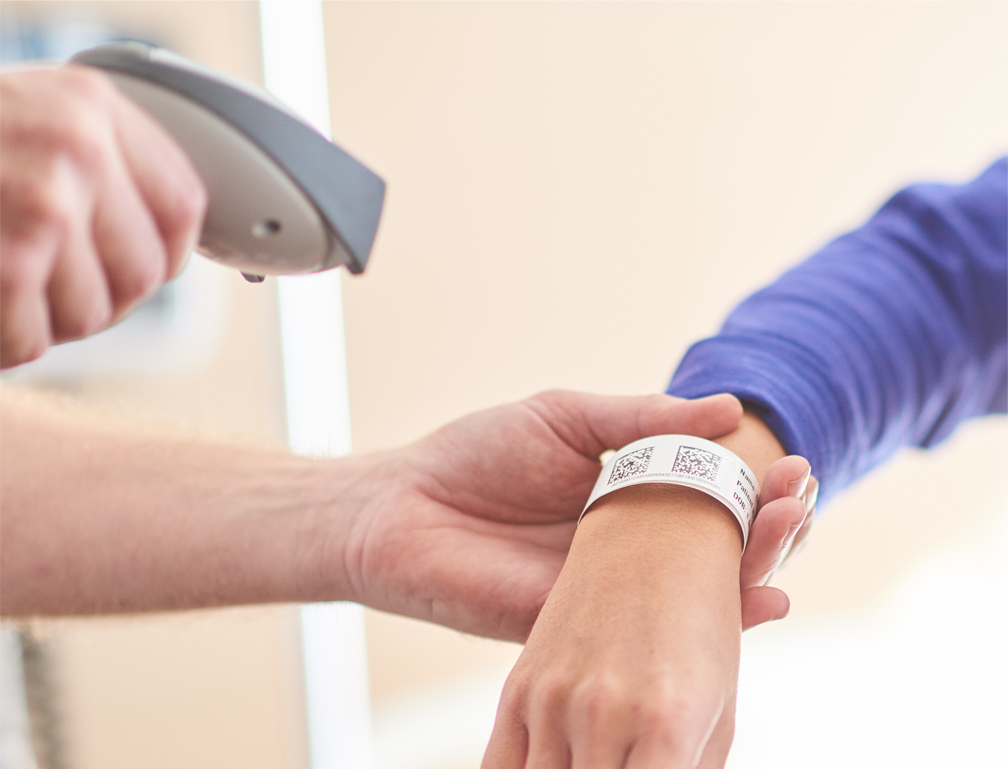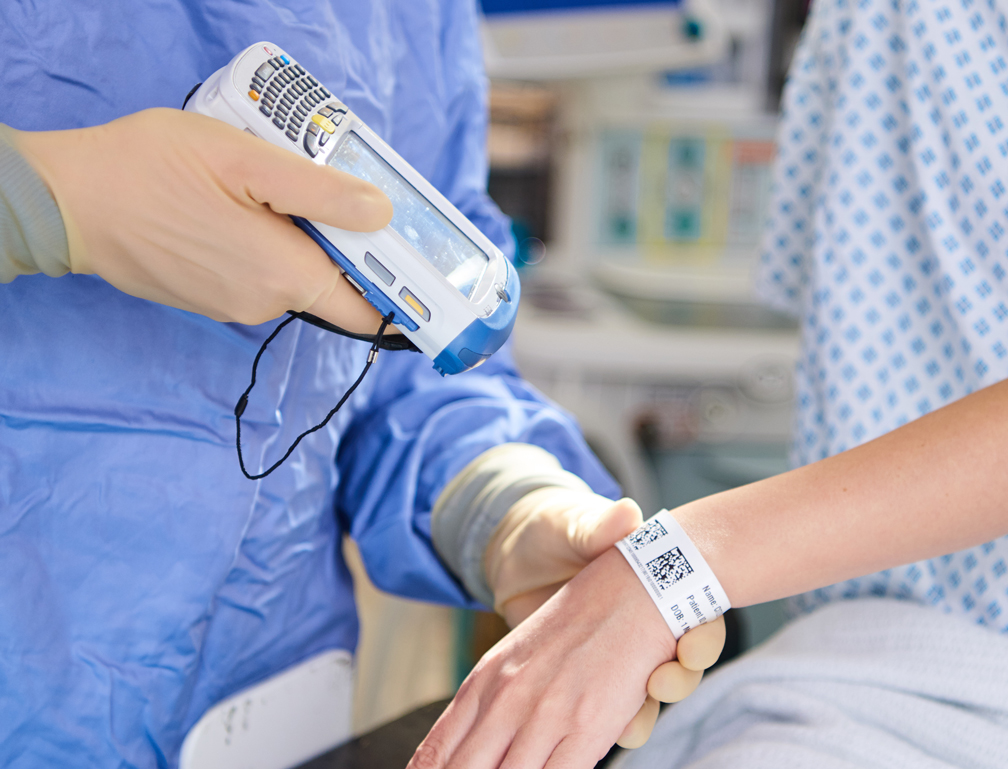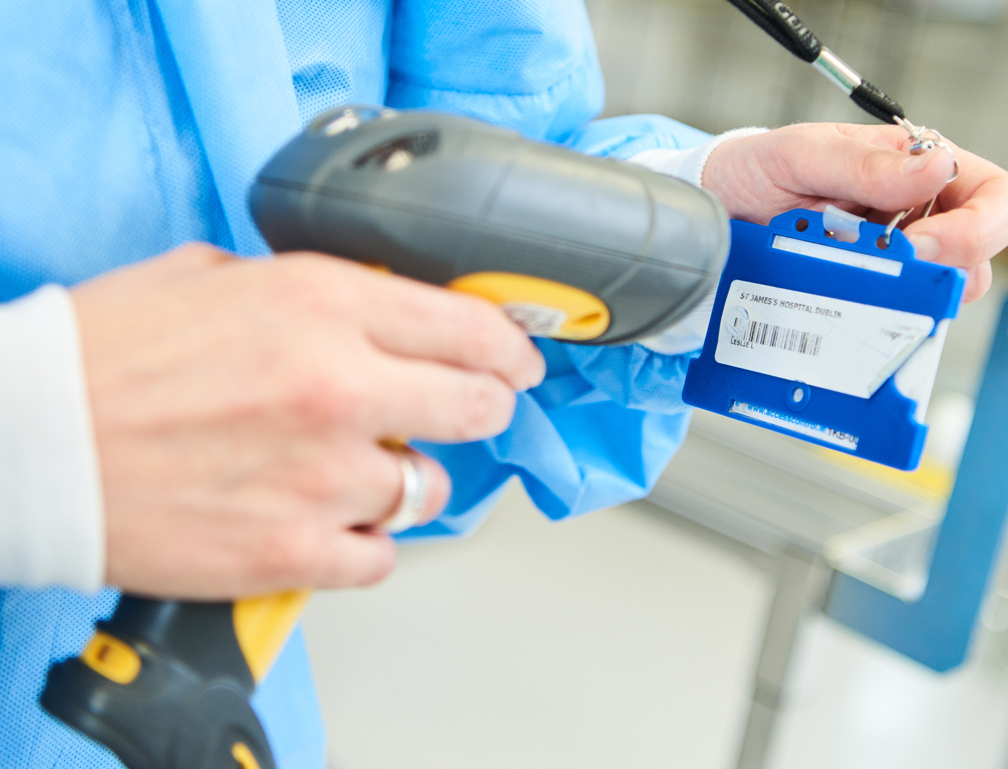Unambiguous identification of patients and staff allowing for greater traceability throughout the patient care journey.
GS1 standards are used to uniquely identify patient and staff to allow for greater traceability throughout a patient’s care journey. This makes the patient pathway safer while improving efficiency for staff.
The GS1 Global Service Relation Number (GSRN) – a globally unique identifier – is encoded into a GS1 2D DataMatrix barcode to enable Automatic Identification and Data Capture (AIDC), by scanning the barcode at the point of care or use. Data is then captured once and updated in necessary patient or staff records in real time to provide consistency and maintain accuracy at all times.

Patient identification
Accurate positive patient ID
This is as a key requirement for ensuring greater patient safety and is also one of the three core enablers of the Scan4Safety programme.
Upon admission, all patients would be issued with a wristband containing a GS1 DataMatrix barcode. Each barcode will be encoded with key patient details required to be captured at the point of care such as, NHS number, full name, date of birth, hospital and/or ward location, and address for example.
This aligns with the NHS Digital standard for Automatic Identification and Data Capture (AIDC) for Patient Identification, DCB1077, which has been updated from ISB1077.

Improving patient safety
The barcode is scanned at each patient encounter or intervention that takes place along the patient pathway, from admission through to discharge. Events are then recorded in real time and captured directly in the electronic patient record including anything from patient observations and medicines administration, to surgical interventions or implantable devices used.
It provides an additional level of security for NHS staff, allowing them to ensure they have the right patient before conducting any investigations, performing any procedures or administering medications. This helps to prevent Never Events – ‘Serious Incidents that are wholly preventable’.
Benefits of patient ID
Patient safety
Obtain an accurate positive patient ID ahead of any patient intervention
Traceability
Trace medical devices, medications, assets and other products to the right patient
Real-time EPR updates
Observations and results can be captured and updated in real time in the electronic patient record
Improved outcomes
Better monitor patient outcomes and ascertain accurate patient-level information costings (PLICs)
Why use the GSRN?
There is no way to guarantee that a medical record number (MRN) is unique to an individual patient. An MRN may be unique within one hospital organisation, or even a trust.
However, as the healthcare landscape becomes more digital-centric and integration becomes more prevalent, the use of the MRN becomes less reliable. This is because there is a greater risk of another trust using the same MRN to identify one of their own patients in their locality.
As records are shared and integrated, this will inevitably cause risk to patients – even at an ICS level. This presents a need for an interoperable solution, based on unique and open standards such as this, that are capable of enabling this to happen.
The NHS number, when used in isolation, is not globally unique as the same number may be used to identify a patient in neighbouring UK countries. Once information in exchanged as part of a shared care record, or national registry, this is no longer guaranteed to be unique and records may get mixed up in error.
In some instances it is not always possible to obtain a positive patient ID as the NHS number is not always available when needed.
However, by implementing DCB1077 it becomes possible to truly uniquely identify the patient as the GSRN makes the patient record accurate and interoperable for data transfer.

Staff identification
A staff ID badge would include a GS1 DataMatrix barcode which is encoded with any relevant staff information required for use. For example, this can include, but is not limited to, the staff member full name, job title, department, or indicate whether they are permanent or agency.
This number should be used wherever it is necessary to identify staff, such as for the World Health Organisation (WHO) surgical checklist process in theatres, when taking blood, when controlling physical access, or for the NHS Digital national peri-operative database, The Medical Device Information System (MDIS).
In the long term, all personnel working for the NHS, including bank staff, agency staff and volunteers, should be identified by a GSRN to improve patient safety and traceability.
Benefits of staff ID
Patient safety
Authorisation checks can be made to validate a clinician's ID prior to carrying out a procedure.
Staff safety
Accurately record and account for all employees in the event of an emergency.
Saving staff time
Staff can record their clinical details quickly, at the point of care, releasing time to care.
Resource management
Managers can get access to staffing levels to support decisions around staff deployment.
Allocating staff costs
Recording details of staff present during a procedure enables full procedure costings to be determined.
Record keeping
Any required staffing or patient records can be kept up to date with clinician details to maintain integrity.
